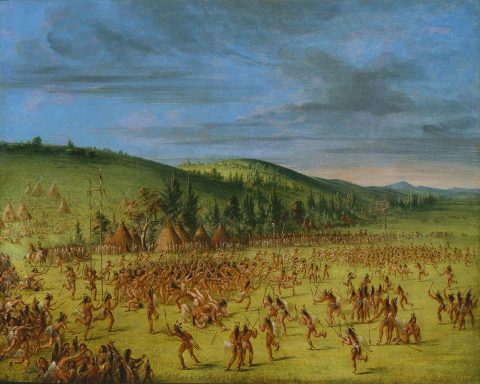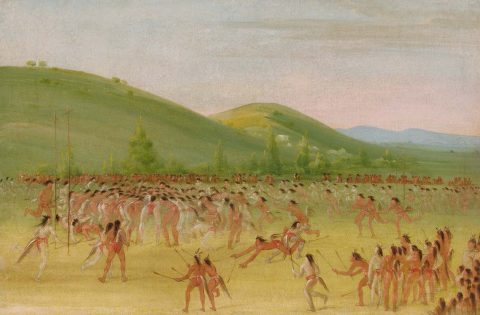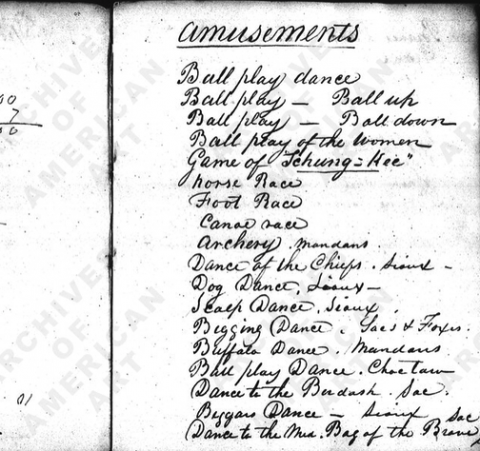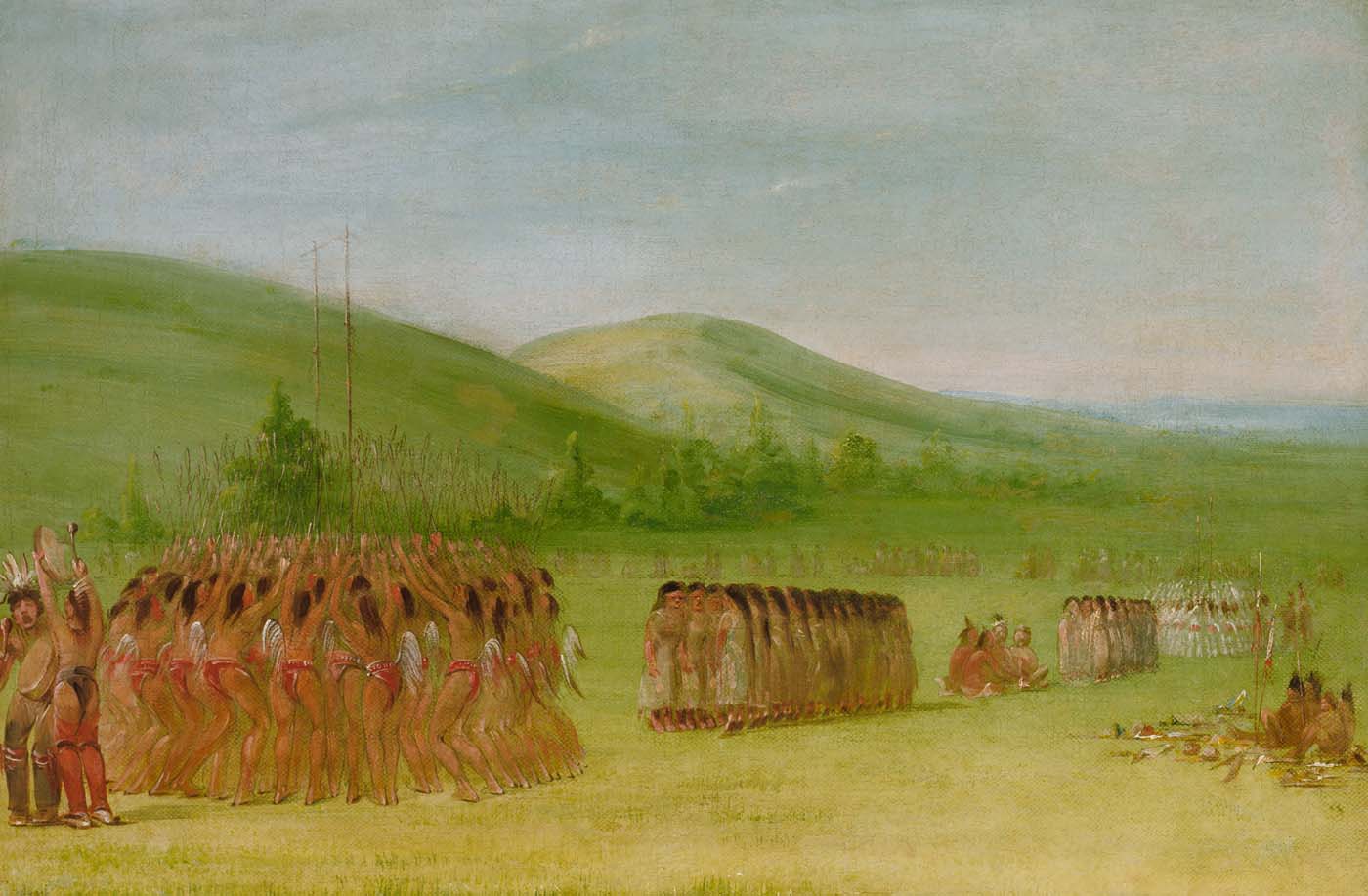It seems fitting to celebrate the Fourth of July playing America’s first real sport—almost like a tribute not to the founders of the Unites States—Washington, Jefferson, Adams—but instead to the original inhabitants of North America—the Iriqouis, the Huron, the Choctaw, the Eastern Cherokee. Most of us know that lacrosse was originally a Native American sport, first observed by French Missionaries near the St. Lawrence River in the 1630s. I’ve always associated lacrosse with the northeast and mid-atlantic, and yes, Canada, but the truth is that the game extended far beyond those territories—especially as Indians were forced to move west with the implementation of the Indian Removal Act under President Andrew Jackson.
 In fact, George Catlin, a 19th century painter who sought to capture Native life before it disappeared and whose works are now housed at the Smithsonian, observed a form of lacrosse played by the Choctaw Indians near Fort Gibson on the Arkansas River in 1834. The Choctaw Nation originally hails from the southeast (think Mississippi, Florida, Louisiana, Alabama), but they were forced to cede their land to the United States in 1830 along with many other tribes. While some opted to stay in Mississippi and conform to U.S. rule, enduring harsh treatment at the hands of white citizens, over 15,000 Choctaw left for the Oklahoma Territory in 1831. During the next two years, well over 2,500 Choctaw would die along the Trail of Tears. When writer Alexis de Tocqueville asked why they were leaving their country, one man responded, “To be free.”
In fact, George Catlin, a 19th century painter who sought to capture Native life before it disappeared and whose works are now housed at the Smithsonian, observed a form of lacrosse played by the Choctaw Indians near Fort Gibson on the Arkansas River in 1834. The Choctaw Nation originally hails from the southeast (think Mississippi, Florida, Louisiana, Alabama), but they were forced to cede their land to the United States in 1830 along with many other tribes. While some opted to stay in Mississippi and conform to U.S. rule, enduring harsh treatment at the hands of white citizens, over 15,000 Choctaw left for the Oklahoma Territory in 1831. During the next two years, well over 2,500 Choctaw would die along the Trail of Tears. When writer Alexis de Tocqueville asked why they were leaving their country, one man responded, “To be free.”
Catlin visited the Indian Territory shortly thereafter. He painted a series depicting nearly seven hundred men participating in play-ball, or lacrosse, with hundreds more spectators on either ‘end line’ making bets. If you look closely, you can see that each of the men carries two sticks as opposed to the one larger stick we’re more familiar with. Catlin described the game as “violent,” and every play involved desperate struggles “where hundreds are running together and leaping, actually over each other’s heads, and darting between their adversaries’ legs, tripping and throwing, and foiling each other in every possible manner, and every voice raised to the highest key, in shrill yelps and barks.”
 Lacrosse was a traditional game and a way to prepare for war, but more than that, it was a spiritual endeavor. As Ansely Jemison, the manager of the Iriqouis Nationals, points out, “We play to give enjoyment to the Creator.” On its website, the Choctaw Nation explains that, “Each team had its conjurer or medicine man, [who] painted his face, wore an appropriate disguise such as a sheepskin beard, and perhaps carried a leafy branch of hickory. The medicine men stood near their respective goals during the play, where they sang, clapped their hands and performed any other actions thought necessary to bring good luck for their team.” Maybe I’m getting carried away, but I believe in the power of cheering on your team and here we’re seeing that idea on a deeper, spiritual plane from players, fans, and conjurers.
Lacrosse was a traditional game and a way to prepare for war, but more than that, it was a spiritual endeavor. As Ansely Jemison, the manager of the Iriqouis Nationals, points out, “We play to give enjoyment to the Creator.” On its website, the Choctaw Nation explains that, “Each team had its conjurer or medicine man, [who] painted his face, wore an appropriate disguise such as a sheepskin beard, and perhaps carried a leafy branch of hickory. The medicine men stood near their respective goals during the play, where they sang, clapped their hands and performed any other actions thought necessary to bring good luck for their team.” Maybe I’m getting carried away, but I believe in the power of cheering on your team and here we’re seeing that idea on a deeper, spiritual plane from players, fans, and conjurers.
On the eve of a big game, the tribe would dance, sing and commune with the divine. Catlin later said, “Night came on without the appearance of any players on the ground. But soon after dark, a procession of lighted flambeaux was seen coming from each encampment, to the ground where the players assembled . . . and at the beat of the drums and chaunts of the women, each party of players commenced the ‘ball-play dance.’ Each party danced for a quarter of an hour . . . and all their voices joined in chaunts to the Great Spirit; in which they were soliciting his favour in deciding the game to their advantage.”
 We talk now about respecting the game—respecting the rules, respecting our teammates, respecting ourselves, our coaches, our fans. Nothing makes me more determined to respect the game than understanding its history. Lacrosse isn’t just a game about winning and losing. It’s about preparing for war, preparing to protect your land, your family, your tribe, your way of life. It’s about accessing a piece of the divine—that spark within yourself that ties you to something greater. So, respect the game. Take a minute to say a silent thank you to its creators. And then get on the wall, because every time you step out on that field you’re representing something larger than yourself.
We talk now about respecting the game—respecting the rules, respecting our teammates, respecting ourselves, our coaches, our fans. Nothing makes me more determined to respect the game than understanding its history. Lacrosse isn’t just a game about winning and losing. It’s about preparing for war, preparing to protect your land, your family, your tribe, your way of life. It’s about accessing a piece of the divine—that spark within yourself that ties you to something greater. So, respect the game. Take a minute to say a silent thank you to its creators. And then get on the wall, because every time you step out on that field you’re representing something larger than yourself.
Post Script: While the images shown to the left feature a men’s game, Catlin’s journal lists the following potential subjects: “Amusements: Ball Play Dance; Ball Play – Ball Up; Ball Play – Ball Down; Ball Play of the Women.” It’s thought that lacrosse was a men’s game in most tribes, but this note leads me to wonder…!
Written By: Courtney Bird
July 7th, 2016
Ball-Play of the Choctaw, Ball Down
George Catlin (1796-1872)
1834-1835
Courtesy of the Smithsonian American Art Museum
Ball-Play Dance, Choctaw
George Catlin (1796-1872)
1834-1835
Courtesy of the Smithsonian American Art Museum
Ball-Play of the Choctaw, Ball Up
George Catlin (1796-1872)
1834-1835
Courtesy of the Smithsonian American Art Museum
http://americanart.si.edu/collections/search/artwork/?id=3885
http://americanart.si.edu/collections/search/artwork/?id=3883
http://americanart.si.edu/collections/search/artwork/?id=3886
https://www.choctawnation.com/history-culture/choctaw-traditions/choctaw-games
http://iroquoisnationals.org/the-iroquois/a-history-of-iroquois-nationals-lacrosse/
http://www.aaa.si.edu/collections/container/viewer/George-Catlin-s-Notebook-6–190051

